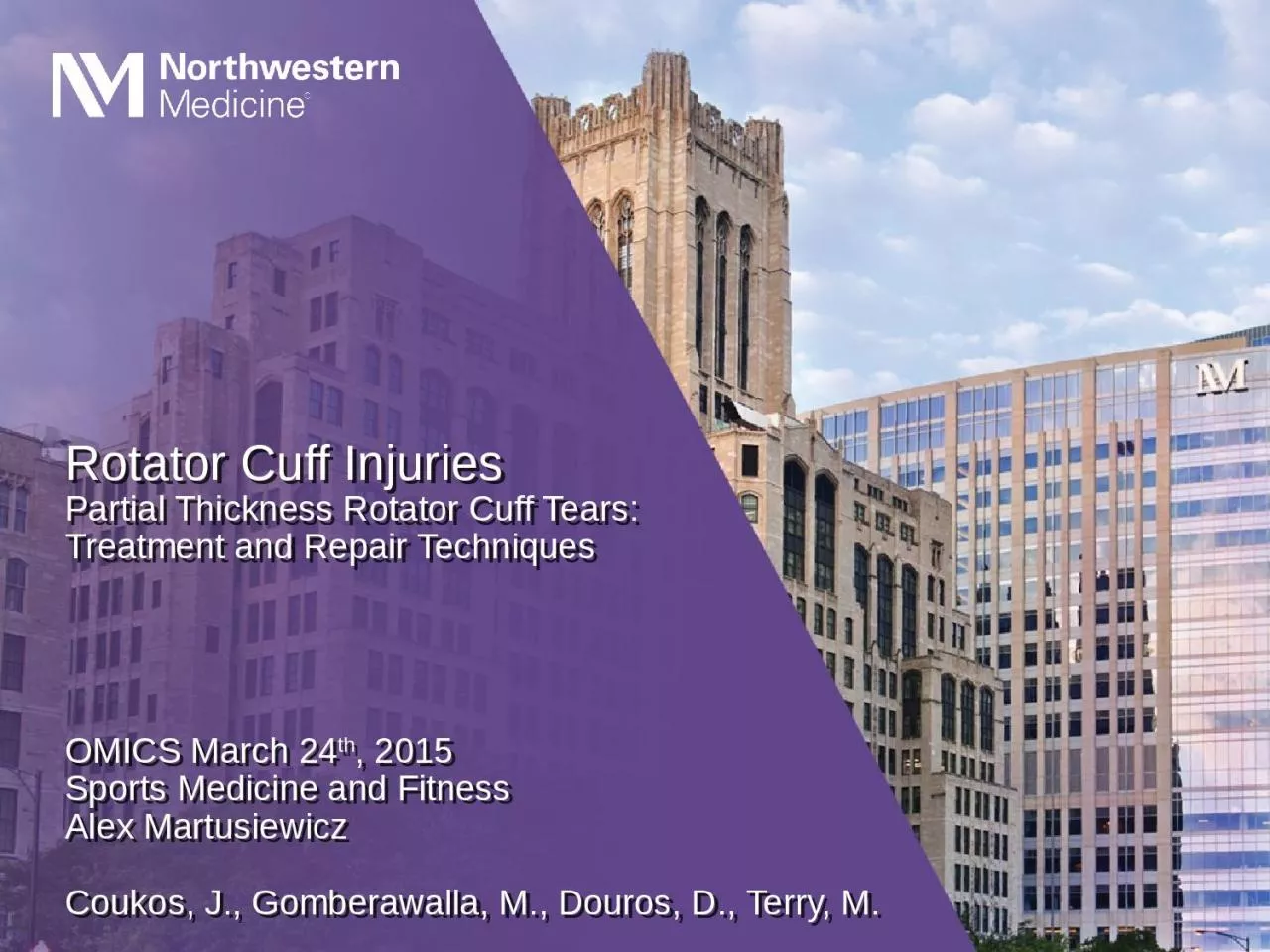

Treatment and Repair Techniques OMICS March 24 th 2015 Sports Medicine and Fitness Alex Martusiewicz Coukos J Gomberawalla M Douros D Terry M Overview Anatomy Classification ID: 1048679
Download Presentation The PPT/PDF document "Rotator Cuff Injuries Partial Thickness ..." is the property of its rightful owner. Permission is granted to download and print the materials on this web site for personal, non-commercial use only, and to display it on your personal computer provided you do not modify the materials and that you retain all copyright notices contained in the materials. By downloading content from our website, you accept the terms of this agreement.
1. Rotator Cuff InjuriesPartial Thickness Rotator Cuff Tears: Treatment and Repair TechniquesOMICS March 24th, 2015Sports Medicine and FitnessAlex MartusiewiczCoukos, J., Gomberawalla, M., Douros, D., Terry, M.
2. OverviewAnatomyClassificationHistoryExaminationImagingTreatment
3. Anatomy
4. ClassificationPartial -Bursal vs Articular < 50% thickness > 50% thickness Complete Organize by sizeNumber of muscles involved
5. ClassificationPASTA:Partial Articular Supraspinatus Tendon Avulsion
6. HistoryPain on the lateral aspect of the shouldermay radiate to deltoid insertionanterior acromion with impingement+/- biceps tendonitisStiffness, especially IRCannot lie on that sideWeakness, instability, crepitusPartial tears more sore and stifferAcute tear may have inciting event
7. Physical ExamInspection: atrophy, symmetryPalpation: AC, cuff tendernessRange of motion: active, passive Strength: ER and elevation power, lag Provocative: impingement sign, arc of pain
8. Physical ExamSpecialized TestsJobe (Empty Can) - SupraspinatusHawkins – ImpingementLift Off – SubscapularisNeer – ImpingementHornblower – Teres Minor
9. ImagingUltrasoundX-rayMRI
10. MRI vs UltrasoundDetection and quantification of rotator cuff tears. Teefey et al. JBJS 200471 patients with shoulder pain had imaging with U/S and MRI then underwent arthroscopy46 full thickness tears19 partial thickness tears6 had no tearU/S and MRI had comparable accuracy for identifying and measuring size of partial and full thickness tearsMRI slightly more sensitive
11. Imaging
12. Imaging
13. TreatmentMainstay is conservativeSurgery reserved for significantly symptomatic patients who have failed conservative management > 6 -12 monthsYounger patient (<60) with acute tearCuff repair within 6 weeks
14. TreatmentConservative Treatment CandidatesPartial thickness tearsOlder patients with chronic large tears and extensive cuff muscle atrophyNSAIDsSymptom control ± ↓ inflammationPhysical TherapyRotator cuff strengtheningPain free ROMStrengthening shoulder girdleImproving biomechanics and proprioceptionCorticosteroid InjectionsSubacromial injection if impingement thought to be primary cause of symptoms
15. Indications for SurgeryFailed conservative management3 to 12 month course of NSAIDs, therapy, corticosteroid injections, activity modificationSignificant or progressive weakness, esp. acuteEarly repair if <50 y.o. and full-thickness tearDifferential diagnosis confirms weakness is from rotator cuff tear (i.e. MRI findings correlate with exam, rule out other causes)
16. Contraindications to SurgeryAsymptomatic tearChronic “massive” irreparable tearsTendon retraction past glenoid rimFatty degeneration of muscleIncreased width of subtrapezial fat padFrozen shoulderNeed ROM pre-opUnwilling or unable to participate in post-op therapy
17. Surgical TechniquesDebridementDecompression and acromioplastyRepair“Complete the tear”Trans-osseousTrans-tendon
18. Surgical Techniques-Trans-interval rotator cuff repairRotator Interval:capsule, SGHL, and the coracohumeral ligament that bridge the gap between the supraspinatus and the subscapularis
19. Surgical Techniques-Trans-interval rotator cuff repairRotator Interval:capsule, SGHL, and the coracohumeral ligament that bridge the gap between the supraspinatus and the subscapularis
20. Surgical Techniques-Trans-interval rotator cuff repairIdentify tearPrepare footprint
21. Surgical Techniques-Trans-interval rotator cuff repairInsert anchor through the rotator interval- 5 mm double loaded titanium anchor
22. Surgical Techniques-Trans-interval rotator cuff repairCreate subacromial portalPass two suture limbs through rotator cuff with suture lassoTie in subacromial space
23. Surgical Techniques-Trans-interval rotator cuff repairRespects intact tendon and supraspinatus footprintAvoids creating a breach close to the rotator cuff insertion
24. Surgical Techniques-Trans-interval rotator cuff repair14 patients retrospectively identified with a PASTA tear who met criteria (< 50% tear, refractory to conservative treatment) - 10 Males, 4 Females - Dominant arm in 11/14 patients - Average age: 56 - Mean clinical follow up: 28 months
25. Surgical Techniques-Trans-interval rotator cuff repairASES Shoulder Score used as an outcome measure - 95.8 out of 100 (95% CI: 91.8- 99.8) 11/14 Patients had complete resolution of pain92% of patients stated that they would repeat the procedure again
26. ConclusionsThorough examination and appropriate imaging are important for diagnosing rotator cuff pathologyImportant to distinguish between partial and complete tearsConservative management should be attempted for partial tearsTrans-interval repair provides reliable pain relief while respecting the intact tendon and supraspinatus footprint
27. References"We Provide Medical Images." Silkfactory. Web. Feb 3. 2015. <http://www.silkfactory.com/2015/02/13/we-provide-medical-images/>Fox, J.A., Romeo A.A., PASTA Lesion-Trans-Tendon Technique for Repair. Operative Techniques in Orthopaedics, Vol 12, No 3, 2002 pg. 191-196.Penello, D. Rotator Cuff Tears. Upper Extremity Rounds. Feb 22, 2006."Rotator Cuff Tear." Rotator Cuff Tear. Web. 20 Mar. 2015. <http://www.londonortho.co.uk/private/RCT.htm>."Rotator Cuff Tears." Rotator Cuff Tears. Web. 21 Mar. 2015. <http://www.shoulderdoc.co.uk/articletile.asp?article=61§ion=22&tile=4>.Teefey et al. Detection and quantification of rotator cuff tears. JBJS 2004, Apr;86-A(4):708-16.
28. Thank YouJohn CoukosDr. Mustafa GomberawallaDr. Michael Terry